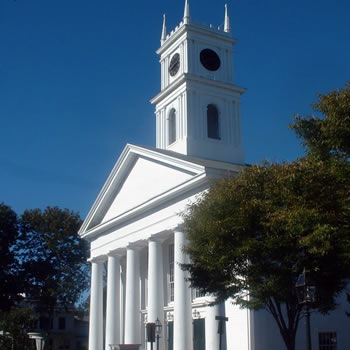 Most important for keeping the authentic, unique character of Martha’s Vineyard is preserving historic buildings and other historic resources from destruction or inappropriate alteration. Most of the Island’s historic buildings are concentrated in historic town centers, traditional neighborhoods, and along historic roads.
Most important for keeping the authentic, unique character of Martha’s Vineyard is preserving historic buildings and other historic resources from destruction or inappropriate alteration. Most of the Island’s historic buildings are concentrated in historic town centers, traditional neighborhoods, and along historic roads.
-
Historic Areas: These areas have high concentrations of buildings over a hundred years old including the town centers of Edgartown, Oak Bluffs, Tisbury, West Tisbury, and Menemsha.
-
Traditional Neighborhoods: These areas, outside the Historic Areas, have high concentrations of buildings built before the end of World War II, and/or where the urban pattern was set before the War.
-
Scenic Roads: The main roads of the Island, all of which pre-date World War II, are significant for a combination of historic, natural, and visual reasons.
Some 2,000 buildings more than 100 years old still stand on the Vineyard, as do another 1,500 built before the end of World War II. Of these 3,500 buildings, about 930 are located in the Island’s six designated Historic Districts (which cover 502 acres), four of which are on the National Register of Historic Places. Another 1,900 are concentrated in Historic Areas (about 2,000 acres for the Island) and Traditional Neighborhoods (about 500 acres) identified in the Island Plan, but are not subject to any protection.
As development pressure increases in the future, the Island’s historic buildings and other resources will be increasingly threatened by demolition, disfigurement, and inappropriate new construction that undermine the character of historic buildings, streetscapes, scenic roads, traditional villages, and other historic areas.
Inventories
A decade ago, historic building surveys were undertaken for parts of all six Island towns. Some of the surveys updated earlier, incomplete survey forms. Though this was not an exhaustive inventory, more than 150 structures and places were recommended for nomination to the National Register of Historic Places or Districts and additional properties were recommended for further study.
- Status of Inventories: Describes the status of studies already undertaken and identifies the possibility of additional surveys.
- Massachusetts Historical Commission Inventories: View their website (MACRIS) to see their detailed inventory info for buildings, structures, areas, etc.
- Historic Inventory Dashboard: In 2022, the MVC released the Historic Inventory Dashboard which allows one to search for a property and view the property's:
- Town Assessor's building and assessed info
- MHC/MACRIS Inventory info
- Local Reconnaissance Survey info
Historic Preservation
Massachusetts law provides for protection of historic districts, but not for individual historic buildings unless they are of state-wide importance. Creating an historic district requires a two-thirds vote at town meeting. After a district has been created, any demolition or alteration to a building exterior must be approved by the historic district commission.
-
Edgartown Local Historic District (about 185 acres and 676 buildings); which is also part of the Edgartown Village Historic District (on the National Register since 1983)
-
Cottage City Historic District, Oak Bluffs, (125 acres and 413 buildings),
-
William Street Historic District, Tisbury (20 acres and 79 buildings); also on the National Register since 1983,
-
West Tisbury Historic District (237 acres, 146 buildings)
-
The West Chop Club Historic District, Tisbury (19 acres and 6 buildings), on the National Register since 2007).
-
Gay Head - Aquinnah Town Center Historic District (70 acres, on the National Register since 1999), [is it 240 acres since 2001?]
-
Wesleyan Grove (Methodist Campground) in Oak Bluffs (33 acres and 284 buildings), on the National Register since 1978 and a National Historic Landmark since 2005.)
In addition, the Copeland Plan District Oak Bluffs (140 acres and 456 buildings) is designated by the MVC as a District of Critical Planning Concern.
In May 2015, the MVC prepared a compilation of documents about the Historic Districts on Martha's Vineyard including statistics, bylaws, and guidelines.
Links to Historic Districts
The Island Plan proposed to ensure that new buildings fit their context by enlarging historic districts to include the highest concentrations of historic buildings, and setting up a more limited design review process for traditional neighborhoods identified in the Island Plan.
Archeology
Native settlement on Martha's Vineyard goes back about 12,500 years and the remains of Wampanoag occupation of the land lie beneath our feet in many parts of the Island. It is important that these archeological artifacts be preserved.
Archeological surveys have been carried out for all towns of the Island except Tisbury, but the results are not generally available because of concerns about pillaging of important sites.
The Commonwealth of Massachusetts has regulations dealing with archeology, especially with respect to human remains. Any new construction projects or renovations to existing buildings that require funding, licenses, or permits from any state or federal governmental agencies must be reviewed by the Massachusetts Historical Commission for impacts to historic and archaeological properties. When the MVC reviews a project as a Development of Regional Impact in an area known to have archeological artifacts, it will usually ask that the archeological resources be assessed and protected.
If you are contemplating any kind of excavation, it would be wise to check with the Wampanoag Tribal Historic Preservation Officer to find out whether there is a likelihood of finding archeological artifacts on your property. They can also work with you to find the best way to protect these artifacts.
Useful Links
- Links to Martha's Vineyard Historic District Regulations (Martha's Vineyard BuyerAgents)
- Massachusetts Historical Commission

